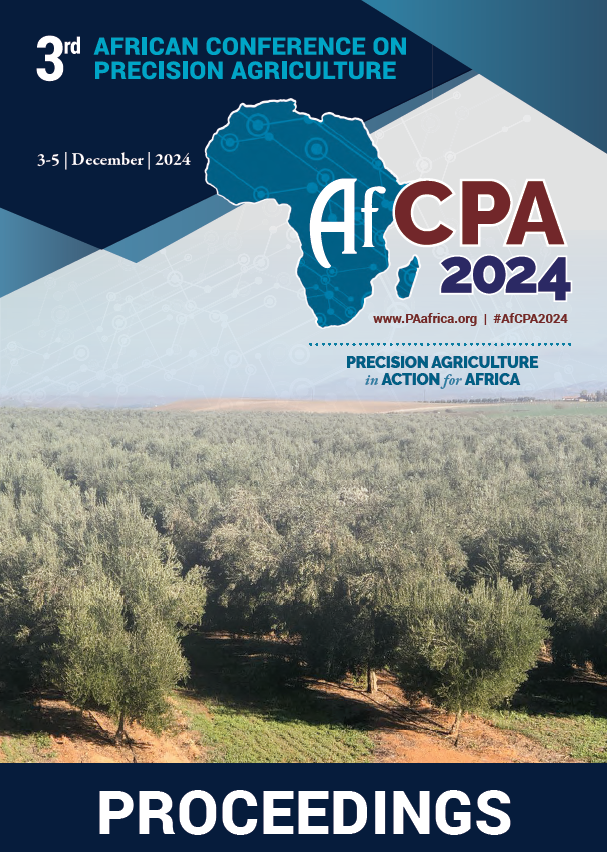Download the Conference Proceedings
Proceedings
Topics
| Filter results7 paper(s) found. |
|---|
1. Modelling Fertigation and Micro-Climate Parameters for Greenhouse Tomato (Solanum Lycopersicum L.)Amidst the hiking price of fertilizer and projected water scarcity across the world, it is imperative to explore the interaction between fertilizer, irrigation and genotype notwithstanding the micro-climate parameters so as to maximize yield while protecting the environment. The Decision Support System for Agrotechnology Transfer (DSSAT) is a model which employs all these input factors to help predict yield and thereby make an informed decision. The study sort to calibrate and validate ... Y.K. Agbemabiese, P. Abubakari, P.K. Dzomeku, I. Shaibu |
2. Optimizing Water Use Efficiency in Flood Irrigation Systems in UgandaThere is growing demand for water across different sectors of production. Yet the extent of water wastage to furnish inefficient irrigation systems especially in flood irrigated rice systems, is not known. In developing countries and in Uganda particularly, most irrigation scheduling in the irrigation schemes is based on rotational system rather than crop water needs. In Doho Rice Irrigation Scheme (DRIS) in eastern Uganda for example, farmers’ plots receive up to 50mm ponding of irriga... P. Onen, E. Opolot, G. Olupot, G. Aguttu |
3. Strengthening the Knowledge Base for Sustainable Management of Inland Valleys in West Africa: Two Pilot Case Study Sites from Benin.Inland valleys offer a unique opportunity for increasing food security in West-Africa, but their potential is constrained by poor water management and a limited hydrological understanding. Increasing the hydrological understanding of inland valleys should be based on long term and detailed validated observations of hydrological fluxes in the different components of the inland valleys. We present in this study, two new pilot case study sites which aim observing the long-term dynamics of ... M.A. Tidjani, P.G. Tovihoudji, I.P. Akponikpe, M. Vanclooster |
4. Soil Moisture Sensing for Increased Water Use Efficiency and Crop Yields in Furrow Irrigated Systems: a Case of Mubuku Irrigation Scheme in UgandaWater and nutrient use efficiencies remain low in most of the irrigated systems in developing countries, undermining crop productivity in these areas. This is partly due to lack of precise and site-specific information to guide irrigation scheduling. In most cases information on soil properties and crop water requirements is lacking and thus irrigation scheduling is done on rotational basis whether the crop needs water or not. Consequently, the amount of water stored in soil root zone for cro... E. Opolot, D. Besigye, P. Musinguzi, I.N. Alou, T.A. Basamba, G. Olupot |
5. Delineation of Management Zones of Irrigation Schemes in Nigeria Based on Selected Soil PropertiesEffective field management is required to maximize economic returns and environmental control and soil and crop management. This study was conducted to delineate the management zones (MZ) of Oke-Oyi and Eiyenkorin Irrigation Schemes (EOIS) based on selected soil properties to aid efficient water and fertilizers use and enhance productivity. Soil samples were taken at goe-referenced grid-sampling points. Total soil samples collected for each location at 0 – 20 cm and 20 – 40 cm dep... A.A. Wahab, O.J. Olaniyan, E.H. Ahamefule |
6. Irrigation Regimes and Mulching Effect on Fruit Yield and Water Stress Index of Tomato (Solannum Lycopersicum L.) Varieties in the Guinea Savannah Agroecology of Ghana... R. Adombilla |
7. Spatial-Temporal Assessment of Drought in the Northern Region, Ghana... B. Asante |
